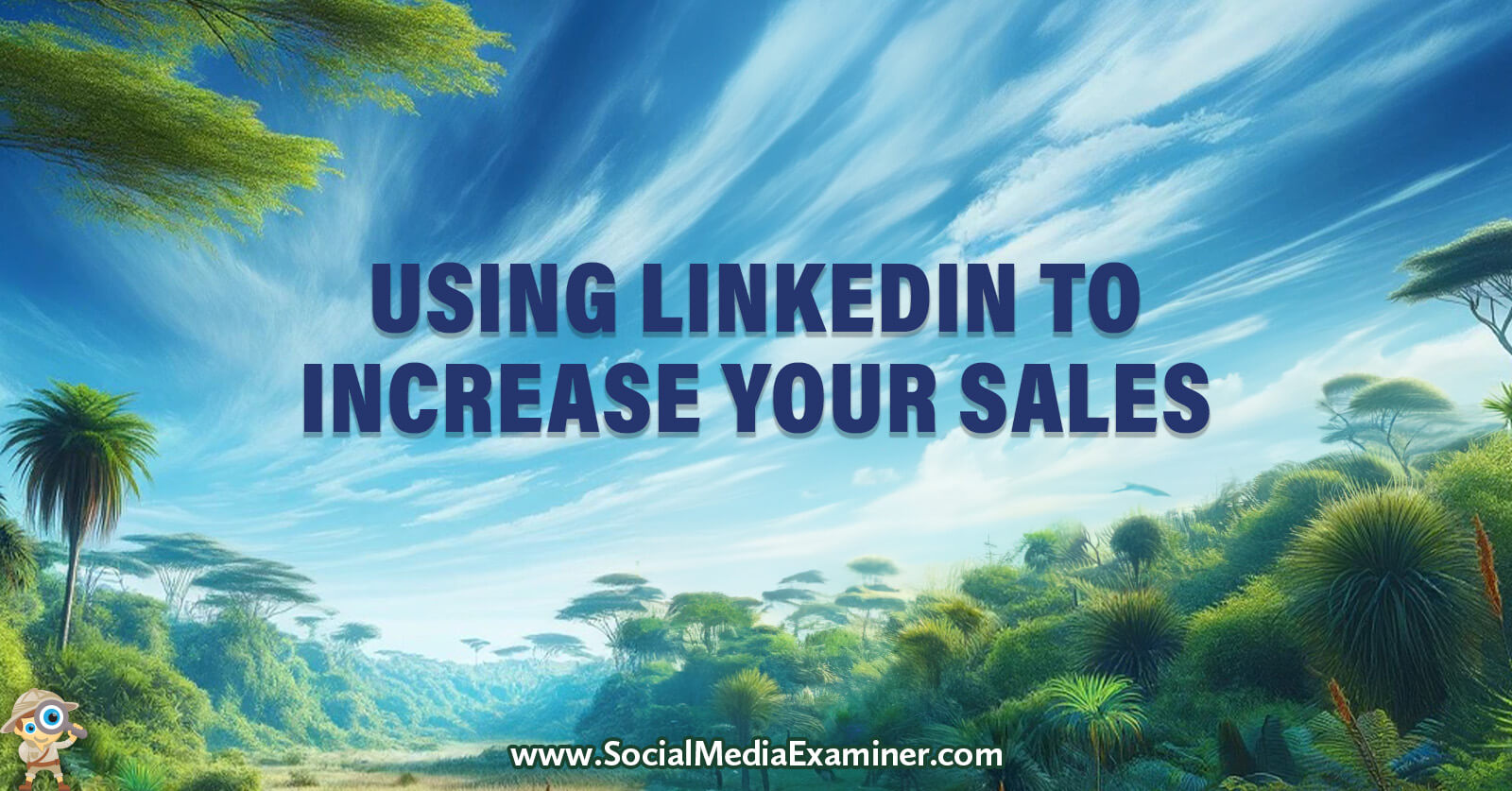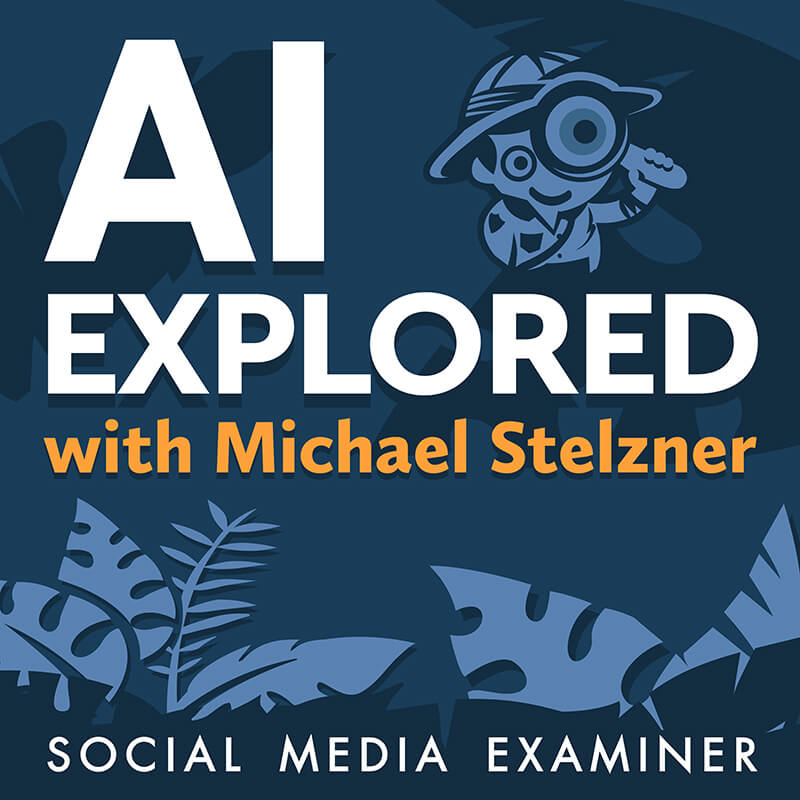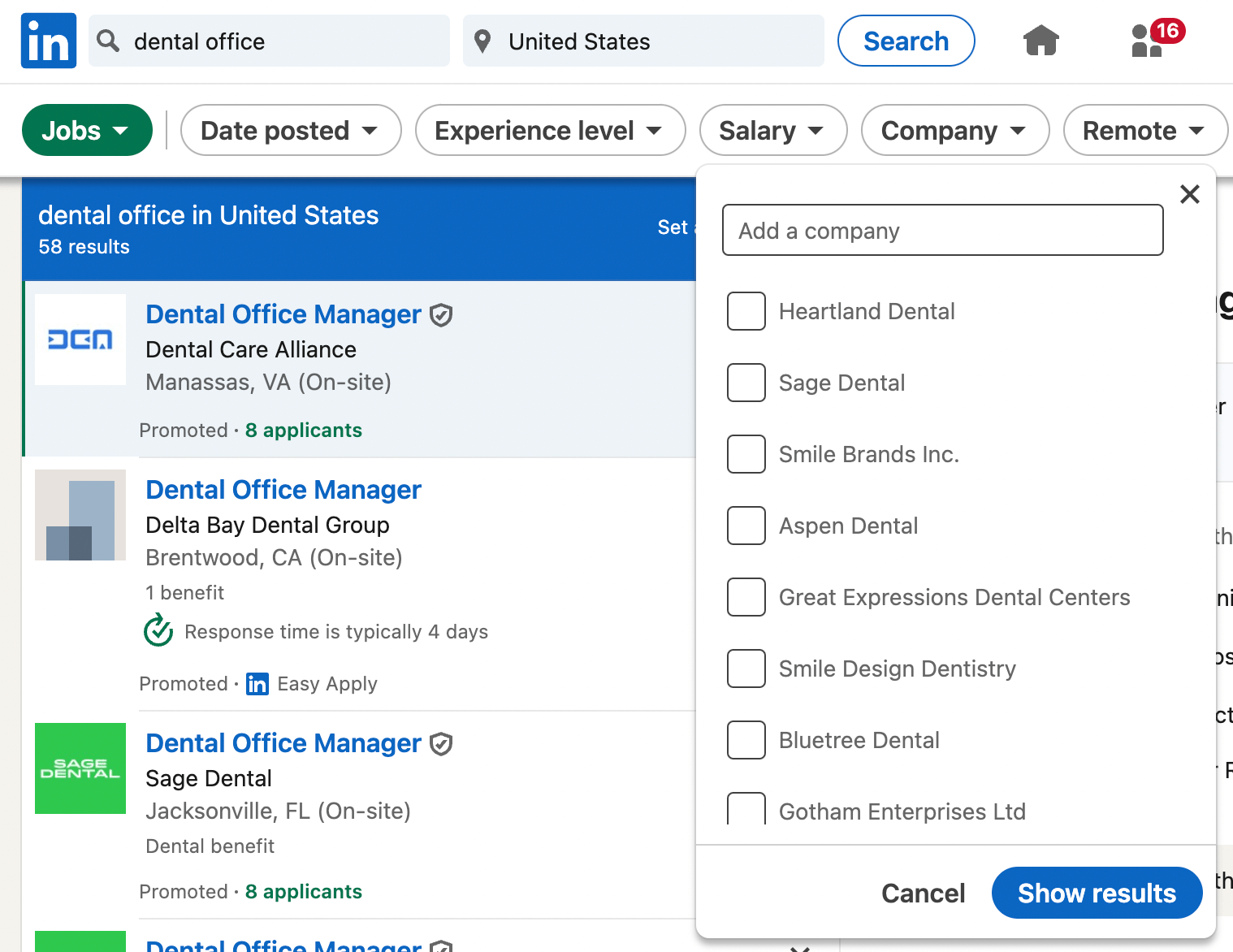Are you looking for strategies to find and convert your ideal prospects? Are you taking full advantage of LinkedIn?
In this article, you’ll discover proven tactics to identify your target audience, craft compelling messages, and guide prospects through your sales funnel on LinkedIn.

Why Should Marketers Focus on LinkedIn for Sales?
LinkedIn has emerged as one of the most powerful platforms for businesses and marketers looking to connect with their ideal prospects and drive sales.
LinkedIn expert and host of the Young and Profiting podcast, Hala Taha, shares her valuable insights on harnessing the power of LinkedIn to increase your sales. She says the platform offers distinct advantages for marketers and sales professionals looking to find qualified leads:
- People on LinkedIn have money to spend. The average LinkedIn user earns over $75,000 annually and is in their peak earning and buying years between ages 25 and 55.
- LinkedIn users are there to learn and make decisions. Unlike other social media platforms, which focus on entertainment or socializing, people come to LinkedIn primed to have business conversations and find solutions to their problems. This makes them much more receptive to sales outreach.
- The competition for attention is lower. Only 5.2% of LinkedIn's 135 million daily active users create original content, meaning there is far less noise to cut through than on other social channels. Well-crafted content is more likely to reach its target audience.
- You can reach your ideal prospects at scale. LinkedIn's powerful search capabilities allow you to find and connect with decision-makers based on attributes like job title, company, location, university affiliation, group membership, event attendance, and more. No other platform offers this level of professional targeting.
How LinkedIn Has Evolved (and What It Means for You)
LinkedIn's algorithm has changed over the years. Understanding how it works is essential for maximizing engagement with potential buyers.
The platform’s algorithm is gradually changing, with the primary trend shifting from prioritizing engagement probability to prioritizing interest relevancy. Engagement probability is about keeping users engaged on the site for as long as possible, similar to the goals of other social media platforms. LinkedIn wants to maximize engagement because it sells ads, so the longer users stay on the site, the more ad revenue they can generate.
However, the platform now emphasizes interest relevancy, showing users content that aligns with their interests, even older content. LinkedIn analyzes each user's “interest graph”—a map of the topics and subtopics they tend to engage with. By understanding users' interests, LinkedIn can surface content more likely to resonate with them, such as suggesting posts.
Previously, fluffy, motivational content tended to get massive reach on LinkedIn. But today, the algorithm favors posts that demonstrate subject matter expertise through the strategic use of meaningful keywords across the LinkedIn landscape—a user's posted content and profile—that align with a user's stated interests and behaviors.
When someone searches for a specific topic on LinkedIn, like “financial advice,” the platform acts like a search engine and looks for relevant content. For example, even if a post about financial advice was created a few months ago, LinkedIn might still show it to the user if it was a high-performing post written by a recognized financial expert.

So, when you search for something, LinkedIn doesn't just show you the most recent or viral posts. Instead, it tries to find the most relevant content based on your interests, even if that means suggesting an older post.
Another unique aspect of LinkedIn is that it uses human editors to review content and ensure it fits its professional brand. LinkedIn wants to be known as a platform for career development, hiring, entrepreneurship, and related professional topics. This editorial focus is driven by their Talent Solutions business model, where employers pay to use LinkedIn as a recruiting tool.
The goal is to provide users with content they genuinely want to see and engage with while maintaining LinkedIn's professional brand identity.
How to Use LinkedIn for Sales
#1: Target Your Ideal Prospects Through Searchable Attributes and Behaviors
One of LinkedIn's superpowers is the ability to identify and connect with your target buyers at scale. Hala shares several organic techniques for finding prospects:
LinkedIn’s Advanced Search
LinkedIn’s powerful free search engine allows you to find people based on multiple criteria and keywords. This feature is handy for identifying individuals who fit your ideal customer persona and would be a good fit for your product or service.
Curious About How to Use AI?

We just launched a new show that help marketers, creators, and entrepreneurs understand the business applications of AI.
It's hosted by Michael Stelzner and explores this exciting new frontier in easy-to-understand terms.
Pull up your favorite podcast app and search for AI Explored. (Look for the cover art shown to the right.)
Or click the button below for more information.
When using LinkedIn's advanced search, you can filter results by:
- Job title: Search for people with specific job titles that match your target audience, such as “VP of Marketing,” “HR Director,” or “CEO.”
- The company they work for: If you have a list of companies you want to target, you can search for decision-makers within those organizations.
- Location: Narrow your search results by specifying a particular geographic area, such as a city, state, or country.
- Past companies: Look for people who have worked at companies that align with your ideal customer profile.
- Schools attended: If you're targeting alumni from specific universities or educational backgrounds, you can search for people based on the schools they attended.

By utilizing these search filters, you can create highly targeted lists of prospects more likely to be interested in your offerings. Once you've identified these individuals, you can connect with them and build relationships.
LinkedIn Groups
LinkedIn Groups are online communities where professionals discuss business topics, share insights, and ask questions. These groups can be goldmines for finding potential customers engaged in conversations related to your industry or niche.
Search for keywords related to your business, industry, or target accounts to see a list of groups that match your search terms. Join the groups that seem most active and relevant to your goals.
Once you're a group member, pay attention to who consistently posts, comments, and starts discussions. These individuals will likely be more open to connecting and having conversations since they're already engaged in the topic.
You can also use groups to demonstrate your expertise by sharing valuable content, answering questions, and participating in discussions. This can help you build credibility and attract potential customers' attention.
Lookalike Profiles
Another effective way to find ideal prospects on LinkedIn is to identify individuals who closely resemble your best customers or are influential in your industry. These “lookalike” profiles can lead you to more people who share similar characteristics and are likely to be interested in your products or services.
Start by listing your top customers or influential people in your industry. Search for these individuals on LinkedIn and visit their profiles. Take note of the following:

Discover Proven Marketing Strategies and Tips
Want to go even deeper with your marketing? Check out the Social Media Marketing Podcast! Publishing weekly since 2012, the Social Media Marketing Podcast helps you navigate the constantly changing marketing jungle, with expert interviews from marketing pros.
But don’t let the name fool you. This show is about a lot more than just social media marketing. With over 600 episodes and millions of downloads each year, this show has been a trusted source for marketers for well over a decade.
- Who is liking, commenting on, and sharing their posts? These people are engaged with content related to your industry and may be interested in what you have to offer.
- What groups do they belong to? Consider joining these groups to connect with more like-minded professionals.
- What events do they attend? Look for people attending the same industry events or conferences, as they may be good prospects.
By exploring the networks of your ideal customers and industry influencers, you can uncover new ways to connect with similar individuals who could benefit from your products or services.
#2: Pull Your Ideal Prospects Into Your Network
Once you've found prospects you'd like to connect with, the next step is to send a personalized connection request that shows relevance and establishes common ground. When reaching out to someone on LinkedIn, the approach depends on whether they are a 1st, 2nd, or 3rd-degree connection.
For 2nd and 3rd-degree connections, you need to send a connection request with a personalized message first. To increase the chances of them accepting, try to be likable in your note or “hook” by asking for advice or giving a compliment—people like people who are similar to them.
Call out why you're reaching out, whether it's a shared interest, membership in a group, a piece of content they engaged with, or something impressive on their profile.
Finding common ground relates to how you found them. For example:
- “I noticed you engage with [influencer]'s content.”
- “I saw you registered for [event] and thought we could connect.”
- “As a fellow [university] alum, I'd love to connect with you.”
The key is to ensure that your message is accurate and personalized. Avoid generic messages at all costs, as they are more likely to be denied or marked as spam. LinkedIn tracks your invitation acceptance rate, so having personalized, relevant messages can help you successfully connect with more people over time.
Suppose you’re trying to reach marketing entrepreneurs on LinkedIn. You look to see who likes and comments on Gary Vaynerchuk’s LinkedIn posts because his target audience is similar to yours. You could reach out to those people by saying, “Hi, I noticed you engage with Gary V's content. If you like his podcast and posts, I think you'll enjoy mine too. I'd love to provide value to you through my content.”

By reaching out to people who already engage with similar content, you can “acquire” followers from the influencer. These new connections will start engaging with your posts, helping you gain more visibility.
Direct Messaging (DM) Your LinkedIn Connections
DMing someone is the highest viral action on LinkedIn. If you DM someone, they are 85% more likely to see your posts.
After accepting your invitation to connect, aim to move your new connections through the sales funnel by providing value and building a relationship.
In a DM, introduce yourself briefly and explain how you help people like them. Then, offer a genuinely useful resource—like an eBook, whitepaper, calculator, quiz, or cheat sheet—that helps solve a problem they face. This should be a high-quality lead-generation magnet that showcases your expertise.
For example, if you connected with a social media manager, you could say: “Hey [Name], thanks for connecting! I'd love to share my free LinkedIn cheat sheet with you. It's packed with tips for optimizing your profile and content. Let me know if you'd like me to send it over!”
Ensure your gated asset links them to a landing page where they enter their email to access the free resource. This gets them on your email list so you can create an opportunity to nurture the relationship outside of LinkedIn. Always end your messages with a question like “What did you think of the cheat sheet?” to encourage a response and keep the conversation going.
Leading Your Connections Through the Sales Funnel
Once you've delivered value, consider inviting prospects to a “mid-funnel” activity that involves a two-way interaction, like a webinar, workshop, or free consultation call. This step is where you can showcase your expertise and continue to provide more value while making a soft pitch to your paid offer. Creating a direct sales pitch is easier since you've nurtured the relationship and are interacting away from LinkedIn.
Your goal is to turn connections into customers by guiding them through your marketing funnel, focusing on providing upfront value.
Tracking Your LinkedIn Connections
If you want to grow your LinkedIn profile and manage outreach, you can use LinkedIn's built-in features to keep track of your messages and connections.
One helpful feature is starring messages. You can star important messages to find them later easily.
Another trick is to use hashtags within your messages. For example, if you're running a campaign with Constant Contact, you could include “#ConstantContact” or “#CC” in your messages. Then, you can search for that hashtag later to find all the relevant messages.
Keeping a spreadsheet is another way to stay organized. You can use it to track different campaigns, connections, and outreach efforts.
The key is to create a daily routine for your LinkedIn activity. This might include:
- Sending new connection requests each day
- Checking and responding to new connections
- Sending messages to new connections
- Following up with existing connections
By having a consistent flow of activity, you can steadily grow your network and build relationships. It's less about perfect tracking and more about regular, targeted effort.
Note: While it may seem tempting to use automation tools to track messages, create audience lists, and manage your outreach, doing so goes against LinkedIn's terms of service. If you get caught, your account could be deleted, which is a big risk, especially for influencers.
Also, if you have a larger team and are considering hiring virtual assistants to help with outreach, be careful because you can only access your LinkedIn account. If you share your login with a virtual assistant, it should be someone you trust, like a relative, intern, or local college student. If the assistant isn't local to you, they should use a residential VPN to log in from your city. This helps avoid raising red flags with LinkedIn.
Hala Taha is a LinkedIn expert and CEO of YAP Media, a full-service marketing agency that helps entrepreneurs, influencers, and brands gain more exposure and sales. She’s host of the Young and Profiting podcast. Her course is the LinkedIn Secrets Masterclass. She’s also founder of YAP Media Podcast Network. You can find her on LinkedIn and Instagram.
Other Notes From This Episode
- Connect with Michael Stelzner @Stelzner on Instagram and @Mike_Stelzner on X.
- Watch this interview and other exclusive content from Social Media Examiner on YouTube.
Listen to the Podcast Now
This article is sourced from the Social Media Marketing Podcast, a top marketing podcast. Listen or subscribe below.
Where to subscribe: Apple Podcasts | Spotify | YouTube Music | YouTube | Amazon Music | RSS
✋🏽 If you enjoyed this episode of the Social Media Marketing podcast, please head over to Apple Podcasts, leave a rating, write a review, and subscribe.
Stay Up-to-Date: Get New Marketing Articles Delivered to You!
Don't miss out on upcoming social media marketing insights and strategies! Sign up to receive notifications when we publish new articles on Social Media Examiner. Our expertly crafted content will help you stay ahead of the curve and drive results for your business. Click the link below to sign up now and receive our annual report!
Attention Agency Owners, Brand Marketers, and Consultants

The Marketing Agency Show helps explore the struggles of agency marketers.
Join show host and agency owner, Brooke B. Sellas, as she interviews agency marketers and digs deep into their biggest challenges. Explore topics like navigating rough economic times, leveraging AI, service diversification, client acquisition, and much more.
Pull up your favorite podcast app and search for the Marketing Agency Show to start listening now. Or click the button below for more information.

